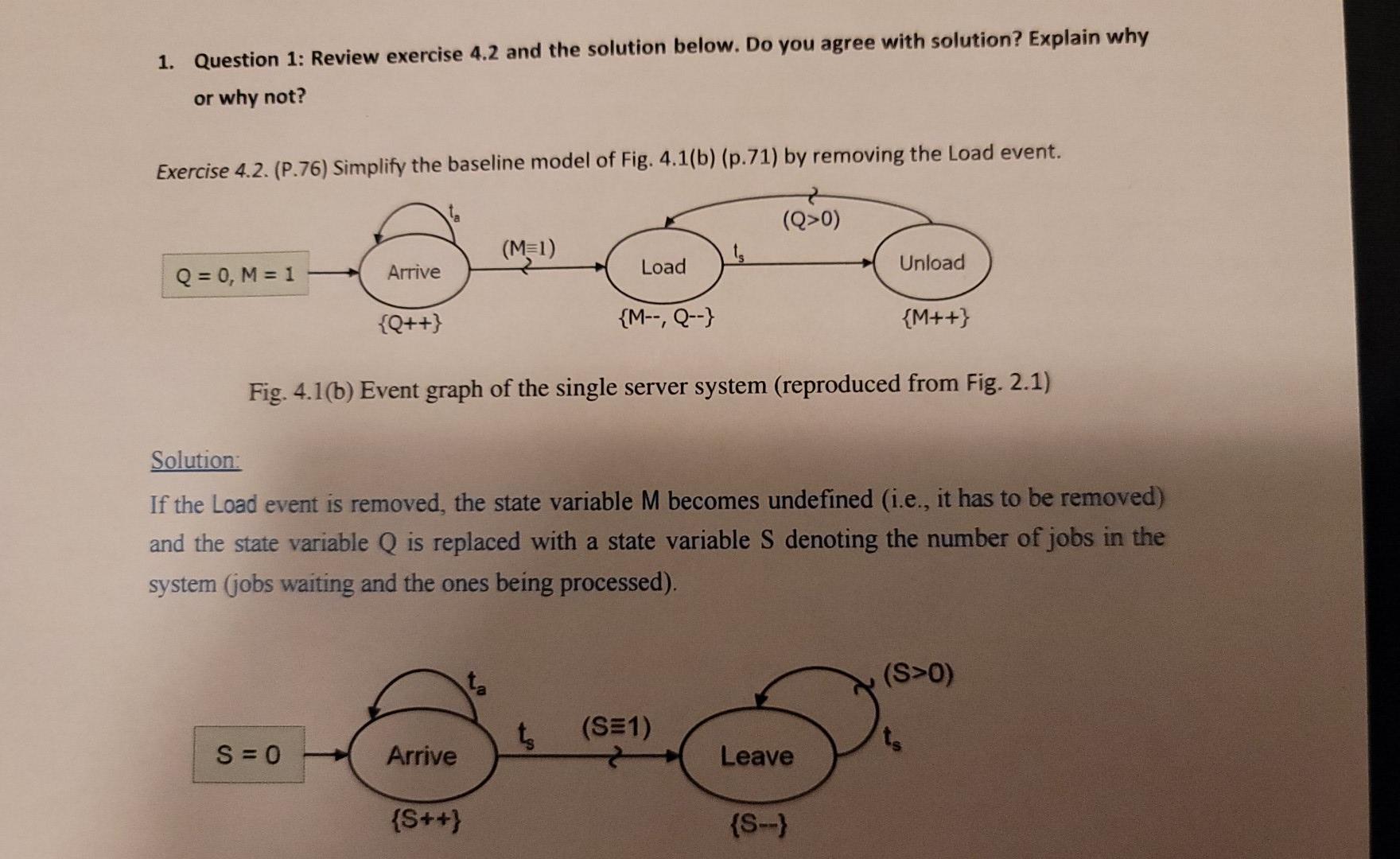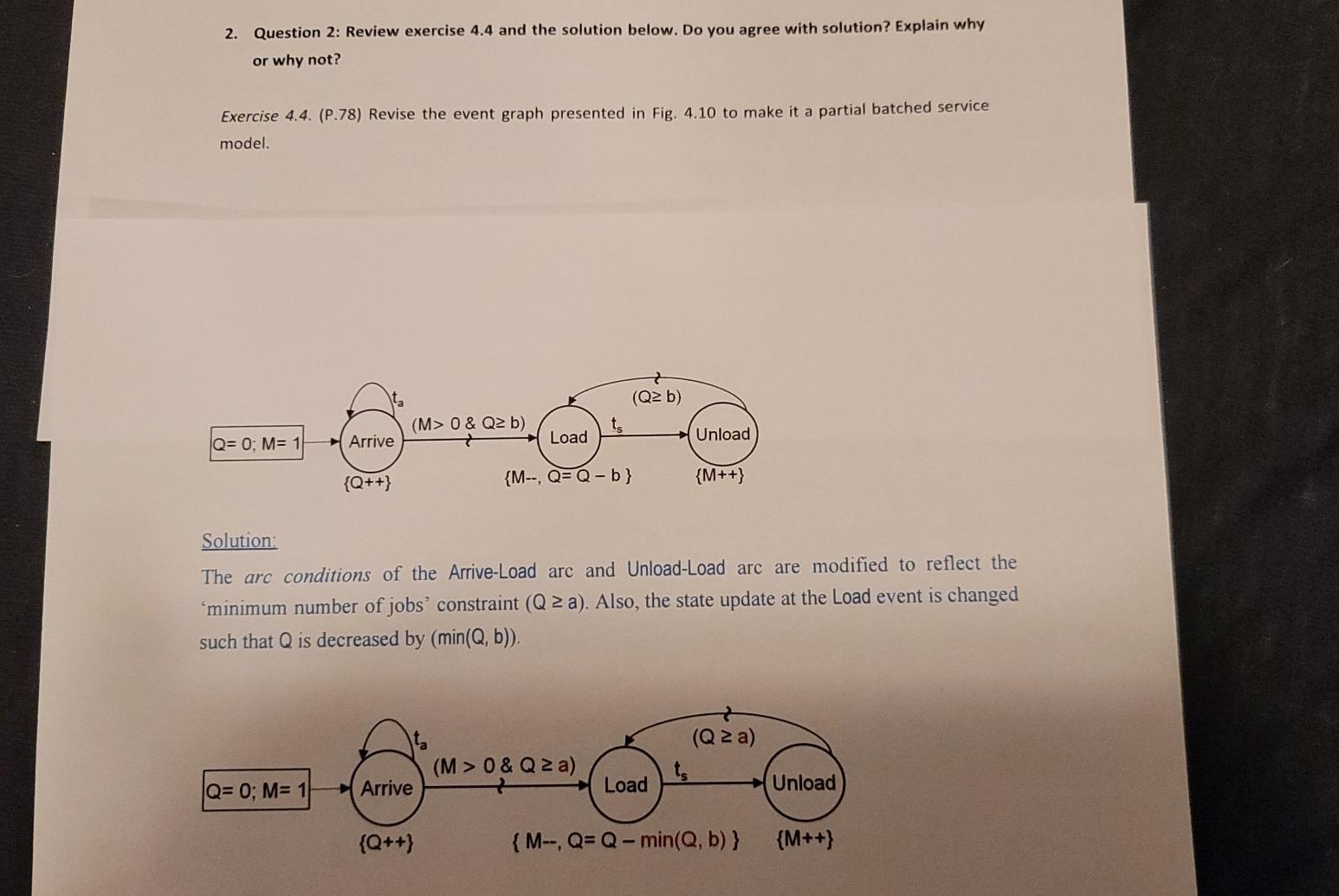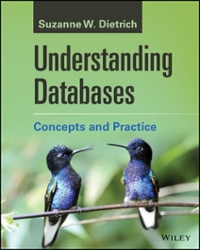Answered step by step
Verified Expert Solution
Question
1 Approved Answer
1. Question 1: Review exercise 4.2 and the solution below. Do you agree with solution? Explain why or why not? Exercise 4.2. (P.76) Simplify the


1. Question 1: Review exercise 4.2 and the solution below. Do you agree with solution? Explain why or why not? Exercise 4.2. (P.76) Simplify the baseline model of Fig. 4.1(b) (p.71) by removing the Load event. (Q>0) (M=1) Q = 0, M = 1 Unload Arrive Load {Q++} {M--, Q--} {M++} Fig. 4.1(b) Event graph of the single server system (reproduced from Fig. 2.1) Solution: If the Load event is removed, the state variable M becomes undefined (i.e., it has to be removed) and the state variable Q is replaced with a state variable S denoting the number of jobs in the system (jobs waiting and the ones being processed). (S>0) ts (SE1) S = 0 Arrive Leave {S++) {S--) 2. Question 2: Review exercise 4.4 and the solution below. Do you agree with solution? Explain why or why not? Exercise 4.4. (P.78) Revise the event graph presented in Fig. 4.10 to make it a partial batched service model. (Q2 b) (M>0 & Q2 b) ts Q= 0; M= 1 Arrive Load Unload {Q++} {M--, Q=Q-b} {M++} Solution: The arc conditions of the Arrive-Load arc and Unload-Load arc are modified to reflect the minimum number of jobs' constraint (Q 2 a). Also, the state update at the Load event is changed such that Q is decreased by (min(Q, b)). (M >0 & Q2 a) (Q2a) ts Q= 0; M= 1 Arrive Load Unload Unload {Q++) {M-, Q= Q - min(Q, b) } {M++) 1. Question 1: Review exercise 4.2 and the solution below. Do you agree with solution? Explain why or why not? Exercise 4.2. (P.76) Simplify the baseline model of Fig. 4.1(b) (p.71) by removing the Load event. (Q>0) (M=1) Q = 0, M = 1 Unload Arrive Load {Q++} {M--, Q--} {M++} Fig. 4.1(b) Event graph of the single server system (reproduced from Fig. 2.1) Solution: If the Load event is removed, the state variable M becomes undefined (i.e., it has to be removed) and the state variable Q is replaced with a state variable S denoting the number of jobs in the system (jobs waiting and the ones being processed). (S>0) ts (SE1) S = 0 Arrive Leave {S++) {S--) 2. Question 2: Review exercise 4.4 and the solution below. Do you agree with solution? Explain why or why not? Exercise 4.4. (P.78) Revise the event graph presented in Fig. 4.10 to make it a partial batched service model. (Q2 b) (M>0 & Q2 b) ts Q= 0; M= 1 Arrive Load Unload {Q++} {M--, Q=Q-b} {M++} Solution: The arc conditions of the Arrive-Load arc and Unload-Load arc are modified to reflect the minimum number of jobs' constraint (Q 2 a). Also, the state update at the Load event is changed such that Q is decreased by (min(Q, b)). (M >0 & Q2 a) (Q2a) ts Q= 0; M= 1 Arrive Load Unload Unload {Q++) {M-, Q= Q - min(Q, b) } {M++)
Step by Step Solution
There are 3 Steps involved in it
Step: 1

Get Instant Access to Expert-Tailored Solutions
See step-by-step solutions with expert insights and AI powered tools for academic success
Step: 2

Step: 3

Ace Your Homework with AI
Get the answers you need in no time with our AI-driven, step-by-step assistance
Get Started


